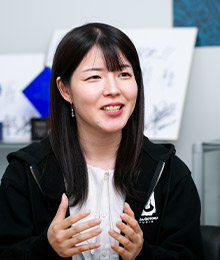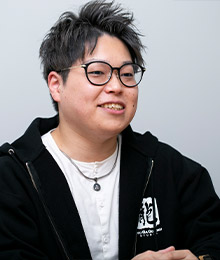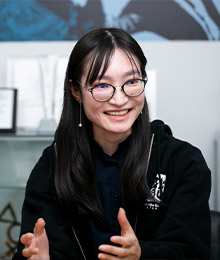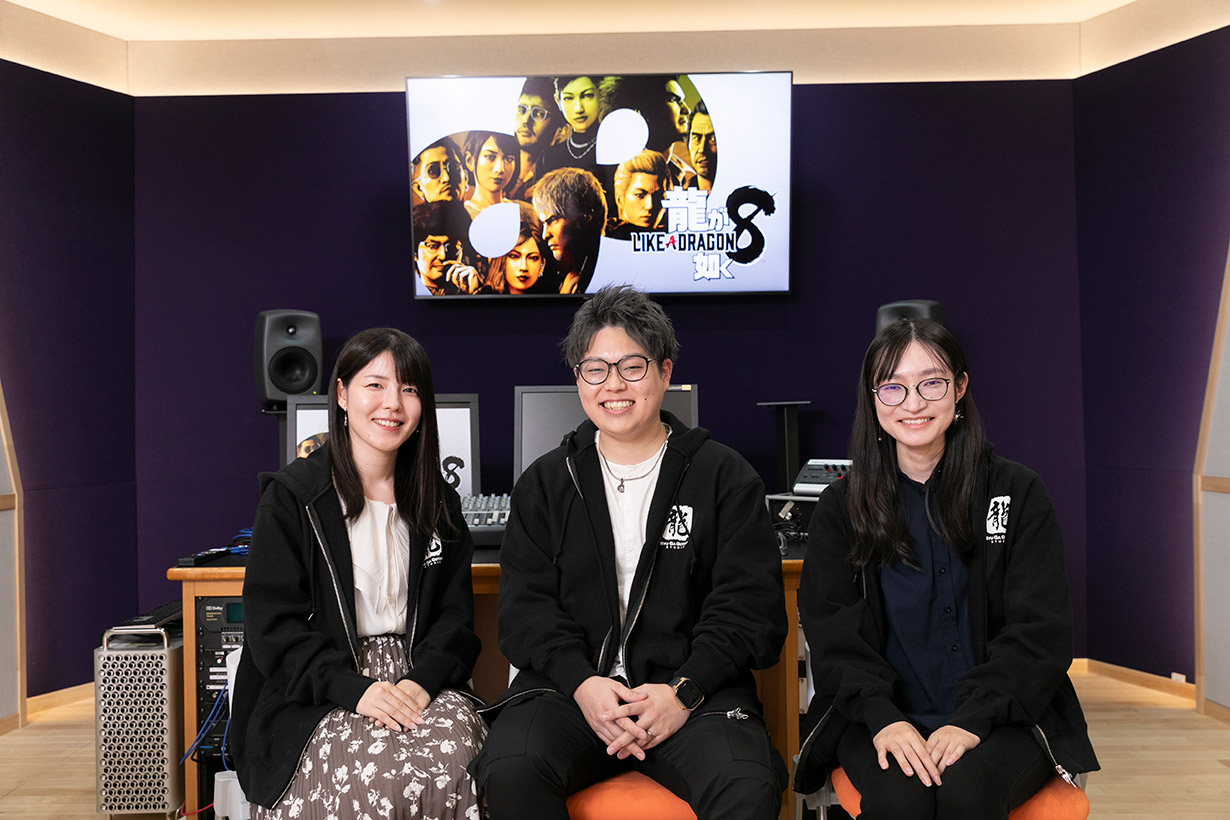The widely acclaimed "Like a Dragon" series has delivered almost twenty years of action-adventure gameplay. SEGA released "Like a Dragon Gaiden: The Man Who Erased His Name" in November 2023, quickly following up with the release of "Like a Dragon: Infinite Wealth" in January 2024—which offers even more high-octane battles and story experiences in the new setting of Hawaii. We'll be speaking to members of its creative team about the behind-the-scenes aspects of the game's development.
The Game Making Process

"Like a Dragon: Infinite Wealth"
Developer Interview
MEMBER PROFILE

Game Designer Sakura Ikeda
Joined in 2020.
Worked on Lost Judgment as a Game Designer. Handled the character bonding events and the new Dondoko Island feature as a Game Designer on "Like a Dragon: Infinite Wealth".

Artist Kyosuke Nakamura
Joined in 2018.
Worked on the PS4 version of Border Break, KanColle Arcade, "Like a Dragon: Ishin!"", and "Like a Dragon Gaiden". Was in charge of character designs for "Like a Dragon: Infinite Wealth".

Programmer Yukimi Tateno
Joined in 2018.
Worked on "Yakuza: Like a Dragon" and "Lost Judgment". Was in charge of programming the UI for "Like a Dragon: Infinite Wealth".
I understand that you joined the production of a popular long-running game series. What were your aspirations for this project, and what was your impression of the team?
I was a huge fan of the "Like a Dragon" series because of its huge range of content, from the overarching main story to substories and minigames. I was thrilled to have the chance to work on them myself. However, even though I knew that the series had many female fans, I was surprised to see how many were a part of its production team.

While I didn't feel any pressure from the expectations of working on a popular title, I had transferred to Ryu Ga Gotoku Studio from a different studio, so I initially felt super nervous about working with people I didn't know.

I had previously worked on "Like a Dragon: Ishin", so I had imagined the department behind the series to be just as stoic as the games. I was surprised to find so many warmhearted and extraordinary people; there's no one here who would fit the vibe of the series.

Yeah, if you just go up and talk to the folks here, you'll find that there aren't any menacing people, haha.
Could you tell me about your role on this project and what you worked on?
I was in charge of the events that allow you to foster stronger bonds with your friends and Dondoko Island, a rundown island that you have to transform into a grand resort. While putting ourselves in the player's shoes, I'd brainstorm ideas about what gameplay elements we could include to make the game even more entertaining.
I designed the game's UI. It took a great deal of effort to implement new elements into the UI without alienating fans or breaking away from the controls and mechanics that previous games in the series had. Sometimes, I'd map functions to the buttons without consulting my colleagues and it'd make the game's controls clunky and unnatural. However, these moments made me painfully aware of how important it was to communicate with the rest of the team.
In "Like a Dragon Gaiden", I was in charge of the designs for the main characters and the characters who'd appear in battle. The main characters of the "Like a Dragon" series hold a degree of realism since they're portrayed by real-life actors. In order to showcase the finest qualities of our characters, we analyze the past performances of actors who served as the models for the characters. We then carefully consider which aesthetics would best complement the character.
What kind of technical difficulties did you face?
The lack of memory gave us some trouble. Setting the story in Hawaii greatly expanded the scale of the game's world, and it also demanded a number of UI features that could showcase the hustle and bustle of Hawaii. After examining and addressing the areas that required more processing power, the artists then demanded the resources to produce more intricate and nuanced designs. To meet their needs, it took a lot of work to optimize the game's technical output without compromising on quality.
Since the series has been around for a long time, using past data would allow us to work more efficiently. However, the fashion that appears in those games would come across as out of style or outdated. Given the complexity of the issue, we decided to bring a fashion consultant on board and were able to integrate the latest fashion trends into the world of "Like a Dragon".

With so many seasoned veterans on the team, were you able to make any suggestions of your own?
Of course! As one of the younger team members, I actually had many chances to comment on the latest trends. It's much easier for people of my generation to pick up on current fashion fads and other social media trends. I wasn't afraid of speaking up—you know, like pointing out what outfits seemed outdated.
I had the privilege to suggest a number of ideas, from large-scale specifications to minor in-game conversations. In fact, some of the small ideas I brought up in our daily conversations were implemented into the game. For example, I'm a huge fan of the character Koichi Adachi. Since he's a bit playful, I casually made a suggestion to my superiors that he should have a scene where he mispronounces "guacamole" as "gwak-uh-moal." That idea later became a Table Talk, a kind of skit where the characters engage in lighthearted banter at a restaurant. While this serves as just one example, it was a great working environment where we had the freedom to suggest any ideas that we had, big or small.
Barely anything is set in stone during the planning stages of "Like a Dragon". We set specifications to establish the overall direction of the project, but it's up to the game designers to decide how to turn it into an actual game. For example, three newer game designers were assigned to work on the new Dondoko Island feature. The game's director gave them two basic briefs: be able to enjoy island life and have the ability to decorate the island. However, once we tested out the feature, we noticed that it was severely lacking. Our team would debate on what we could do to make Dondoko Island more entertaining for fans of the "Like a Dragon" series and ended up creating the life simulation game that you see in the final product.
In my case, I had several chances to provide suggestions. As an example, someone once made a proposal to use a dialogue box to make something in the game easier to digest. Since something like that'd feel out of place in the game, I'd propose alternatives that'd make the formatting feel more organic, like graying out the text or changing its placement.
What kind of advice did you receive from the more experienced team members around you?
To create a character using scans of a real-life actor, we need to preserve the actor's image while giving them a larger-than-life presence only made possible in a video game. When I struggled with creating characters who fit the rugged and overwhelming world of "Like a Dragon", a senior staff member encouraged me to consider incorporating open facial pores and sweat. Their advice helped expand my toolkit for making characters more compelling.
For the development setup of the "Like a Dragon" series, we run automated tests every day, and have a system in place that sends us an email whenever a bug is discovered. Whenever I made a mistake and triggered an error, my superiors would give me advice on how to rectify them and prevent them from happening again.
Once, I had a hard time explaining the points I wanted to make about the game's specifications to the other departments, so my superior gave me a nudge in the right direction. They encouraged me to take each perspective into consideration, like imagining what would visually stimulate the artistic team or what technical aspects the programming team would want to know, and communicating my ideas in a way they'd understand.
This experience taught me the importance of clearly articulating my goals, while also taking into account the roles and perspectives of my team members.

Now that the project is complete, how do you feel you've grown as professionals? What are your next goals?
The Like a Dragon team positively welcomes new tech, so I've managed to broaden my repertoire of tools. Being a game artist involves more than simply replicating reality; I need to pursue a sense of "life-likeness" while delivering imaginative visuals. I still find that many parts of my work lack substance. Nevertheless, I aim to create better visuals that'll entertain players from all walks of life, as the "Like a Dragon" games were intended to be enjoyed by people across the globe.
Through my experience drafting the specifications of the Dondoko Island minigame and balancing it, I feel I've gained some fundamental game development skills. One day, I'd like to take on a bigger role and pitch ideas that'll form the basis for a full-fledged large-scale game, just like the "Like a Dragon" games.
The skills I developed most were my debugging techniques. Whenever I encounter a processing error or a bug, I can now confidently diagnose the root cause of the issue and resolve it. In the future, I'd like to deepen my understanding of UI and broaden my knowledge of how to implement UI on games launching across multiple platforms.
What qualities do you believe make someone a good fit for SEGA, and what unique opportunities are available exclusively at SEGA?
At SEGA, we have a collective wealth of gaming expertise, from seasoned veterans with experience developing arcade games to experts who have an eye for the minute differences in gameplay and UI. No matter what problems you face, we are certain to have the know-how to address them. As a game developer, that's very reassuring.
Due to our strong rapport, it's very easy for young, new staff members to share ideas directly with the directors or producers. Senior team members and our superiors are also always willing to lend an ear and offer their support. Even if you don't have any experience, you'll find ample opportunities here. If you have something you want to achieve, SEGA is the place to do it.
At SEGA, you'll find yourself in the company of highly skilled senior team members who are experts in their respective fields. You'll find specialists in shaders, machinery, structuring, and more! They have a wealth of knowledge and can virtually answer any inquiry you may have. We also have a robust internal training program. I believe no other environment allows you to soak up new game development skills quite like SEGA does.

MAKING








